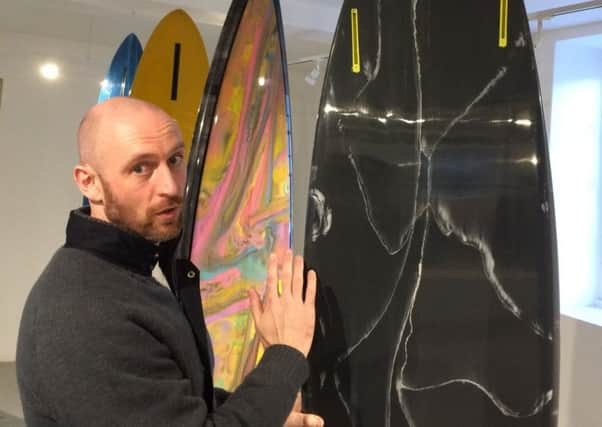Interview: Jason Burnett on the art and science of crafting a custom-made surfboard


An artfully shot video playing on a loop in the gallery showed the various stages that go into creating a custom board: first a polyurethane blank – a sort of rough, generic outline of a surfboard – is carefully cut and sanded into the desired shape; then fins are added to give the board forward momentum (or fin boxes inserted into the underside of the board so that removable fins can be fitted later); then the finished design is covered in layers of fibreglass and resin, which, when dry and sanded smooth, form a protective, watertight shell. Coloured resins are added at this final stage if required, and it’s by experimenting with these unpredictable substances that Burnett gradually found himself making art objects as well as surfboards.
Several of the works on show at Custom Lane were abstract wall panels, made by pouring surplus resin directly onto pieces of canvas. One of them bore more than a passing resemblance to an aerial photograph of a tropical reefbreak, with coral heads visible under aquamarine water. “It evolved that way,” says Burnett, “I poured different colours of resin onto the canvas, moved them about and then watched what happened. The resin takes about 20 minutes to gel up, and even after that it’s still doing stuff.”
Advertisement
Hide AdAdvertisement
Hide AdThe surfboards in the exhibition were in a mixture of styles – some were nods to famous shapers of the past while others represented the cutting edge of contemporary design. At just 4ft 6in long, the Flex Spoon Kneeboard was the most out-there of the six. Inspired by the craft shaped and ridden by California surfer, sailor and inventor George Greenough, star of the 1973 surf film Crystal Voyager, it only has foam in the nose and along the rails; the central portion of the board is just resin and fibreglass, built up slowly, layer upon painstaking layer. “There’s about 16 or 18 layers of fibreglass at the back,” Burnett says, “and it gets less and less towards the front.”
“This board was way ahead of its time,” he continues. “Because there’s no foam here [in the centre of the board] you’re more connected to the surface of the wave.”
Another reference to the history of surfboard design, Burnett’s 7ft Mini-Gun was inspired by the needle-like Lightning Bolt boards that Gerry Lopez built in the 1970s to help him rocket through the grinding barrels of Pipeline, the infamous reefbreak on the Hawaiian island of Oahu. And the board’s sleek contours aren’t the only reference to its heritage – there’s a subtle lightning bolt shape just visible on board’s marbled, multi-coloured deck, and another even more subtle one sanded into its all-black underside.
“This board would be fast,” says Burnett, “but hard to turn. One for a good day.”
Among the more modern designs on show were two asymmetrical boards – one at 6ft, the other at 6ft 4in. These had a straighter toe-side edge to give greater down-the-line speed, but a more rounded heel-side edge, to make backside turns easier.
“If you had curved rails both sides, you wouldn’t be able to drive off your toes as fast as you could off that straight rail,” says Burnett. “But you feel you’ve got more stability and more control than if you’re riding something that’s straight both sides.”
Burnett, who works out of a studio in the Newbattle Abbey Business Park, says he didn’t have any formal training as an artist. He first got into surfing while swimming competitively for Edinburgh clubs. Next, he started doing ding repairs on his own boards – patching cracks and scrapes with fibreglass and resin – and once he’d mastered that, having a go at shaping felt like a natural progression.
There have been many notable shaper-surfer relationships over the years – from Maurice Cole and Tom Curren to Al Merrick and Kelly Slater to Darren Hadley and Mick Fanning – so clearly there’s an advantage to developing a relationship with an expert shaper rather than simply buying a board straight off the rack (or – more likely these days – buying one from the internet). Burnett explains why the surfer-shaper relationship still matters:
Advertisement
Hide AdAdvertisement
Hide Ad“Every surfer surfs differently, and everybody’s surfing to a different ability as well, so it’s about getting something more attuned to them. It’s like walking into a store and getting a suit tailored to you – you end up with something that’s more attuned to you, and something that’s going to help you surf better. And that’s what it’s all about.”
www.jaysurfboards.co.uk